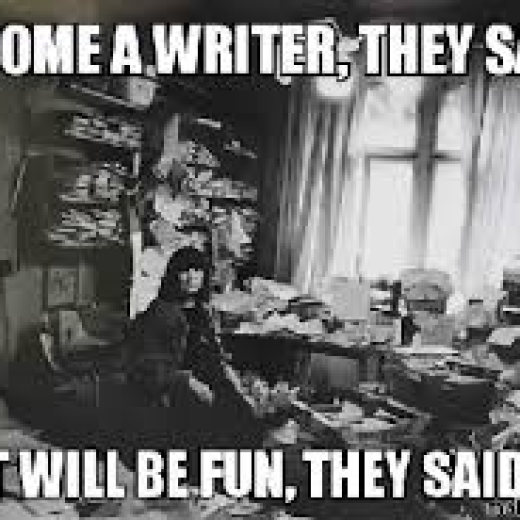He Said, She Glared: The Battle of Action vs. Dialogue Tags by Jami Gray
 Let’s welcome back monthly columnist Jami Gray as she shares with us “He Said, She Glared: The Battle of Action vs. Dialogue Tags.” Enjoy!
Let’s welcome back monthly columnist Jami Gray as she shares with us “He Said, She Glared: The Battle of Action vs. Dialogue Tags.” Enjoy!
***
Ahhh, the joys of tags. These are those pesky things writers tack after a dialogue run. They tell the reader who’s talking or what they’re doing, or sometimes they do both. These innocuous critters have stirred up quite the debate in the writing community. I’m sure you’ve heard them, whispering in the corners of the coffee shop or library:
“I told you, ‘said’ is invisible to readers. Why can’t you get that?”
“Show me what’s going on, don’t tell me.”
Since writing is an individual art, each word-artist holds their opinion close and protected. On one side are those who feel adding “said Imelda” after her speech is perfect. On the other are those who think “said” should be erased from the entire manuscript. Who’s right?
Both and neither.
Frustrated yet? Don’t be. It’s your story, and only you know what will work for your creation. There is a place for both opinions in one story. Here’s why.
- Sometimes the best fit is a simple dialogue tag.
- Sometimes an action tag will bring your readers deeper into your story.
- Balancing these two options is a vital piece of the true art of story crafting.
As a freelance editor, I’ve noticed a pattern among first time novelists, they are deeply attached to their dialogue tags. So much so, they tend to use them incorrectly and on every line of dialogue.
Take the following example, anyone want to guess why this makes an editor cringe?
“That shuffling corpse over there looks hungry, Abe. Think we should bail?” Eilene asked.
Yep, don’t tell us Eilene asked a question, we got that when we noticed the nifty wiggle with a dot underneath it at the end. Maybe give us a bit more of what Eilene’s future plans are, is she getting ready to run? Is she firing up her flamethrower. Readers wanna know.
“That shuffling corpse over there looks hungry, Abe. Think we should bail?” Eilene wondered how big her lead would be if Abe happen to trip over a not-so-helpful foot.
Bet Eilene’s worrying you about now, uh? Let’s try another one:
“Now we’re having fun,” Eilene smiled.
Personally, I’ve never quite figured out how to talk the language of smile or sigh or laugh. Laugh has to be the hardest to understand. These are actions, my budding artist, and they need to be treated as such. Don’t forget, smiles, sighs, and laughs are universal, so add some flavor to help paint a picture.
“Now we’re having fun.” Fierce with viciousness, Eilene’s grin sent chills quaking over flesh.
You ready to run from Eilene yet? Because I’m about four blocks ahead of you at this point.
Granted these two examples are great for deepening point of view and getting your reader closer to your story, but they are pure action tags.
Still a simple dialogue tag can work. Consider the master of simple but curiously elegant dialogue, Elmore Leonard (and yes, I know one of his rules is never use any tag but ‘said’) and this example from his FREAKY DEAKY where the police detective, Chris, is staying at his dad’s apartment after being kicked to the curb by his girlfriend.
His dad said, “You seem to have a lot of trouble with women. They keep throwing you out.”
“I do what she wants, she comes up with something else, I don’t talk to her.”
“I don’t know what it is,” his dad said, “you’re not a bad-looking guy. You could give a little more thought to your grooming. Get your hair trimmed, wear a white shirt now and then, see if that works. What kind of aftershave you use?”
Even without the action tags, you get a clear idea of who is saying what, because each voice is distinctive. Did you notice where the dialogue tags fell? Yep, just on dad’s line. When your character voices are unique, you don’t have to tell us who said what on each line, it should be easy to follow. But don’t forget to include the rest of the non-verbal story, because that is what makes your story unique.
***
ABOUT THE AUTHOR
 Jami Gray is the award winning, multi-published author of the Urban Fantasy series, The Kyn Kronicles, and the Paranormal Romantic Suspense series, PSY-IV Teams. Surrounded by Star Wars obsessed males and two female labs moonlighting as the Fur Minxes, she escapes by playing with the voices in her head.
Jami Gray is the award winning, multi-published author of the Urban Fantasy series, The Kyn Kronicles, and the Paranormal Romantic Suspense series, PSY-IV Teams. Surrounded by Star Wars obsessed males and two female labs moonlighting as the Fur Minxes, she escapes by playing with the voices in her head.
If you want to hunt her down, she can be found lurking around the following cyber locations:
Website: www.JamiGray.com
Facebook: https://www.facebook.com/jamigray.author
Twitter: https://twitter.com/JamiGrayAuthor






As a writer and writing teacher, I found this to be on point and helpful. Thanks, Jami!
Yes, all good. I try to put character and mannerism in front of the “dialog line.”
Thank you, John and Tim. As easy as it sounds, it’s one of the more difficult to accomplish, and tends to come down to personal preferences of the writer. Have a wonderful week!